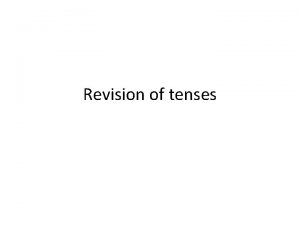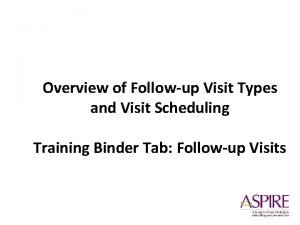Shared Medical Visits What Is a Shared Medical










- Slides: 10

Shared Medical Visits

What Is a Shared Medical Visit? Ø A shared medical visit is usually a 90 -minute medical visit that is shared with 8 to 15 other patients Ø Your doctor, nurse practitioner, or physician assistant is there Ø Other members of your healthcare team may also be there Ø During a shared visit, you still get your own time to be examined and talk about personal issues privately with your doctor

Conditions That Are Often the Focus of Shared Visits Ø Ø Ø Weight control Diabetes High blood pressure Heart disease Asthma Depression Osteoporosis Multiple sclerosis Sleep problems Women’s health Well-care or “preventive care” (physicals, annual exams)

Benefits Ø You get to see healthcare providers who are experts on different topics like: o Disease management o Medication taking o Healthy eating o Behavior and lifestyle changes Ø You get help and tips from other patients who have the same condition and can learn more when you hear: o What other patients are going through o What they ask o The way they fix their problems Ø You get more face time with your doctor than you would in a regular visit and usually feel less rushed

These Types of Visits can… Ø Ø Ø Ø Make you happier with your doctor Make your relationship with your doctor better Cut back visits to specialists Help you do better with your health Help you stay on top of your medicines Help you take better care of yourself Make you happier in general

These Visits Are Your Choice and Are Kept Private Ø Your own medical history and condition(s) are NOT shared with the group as a whole Ø If you want to, you can share your story with other patients Ø You sign a special form (called a “HIPAA” notice) for the group visit that states that you: o Agree to meet with a group of patients and your doctor o Understand that you have the choice to be seen by your doctor in this group or alone o Agree to keep everything that you hear about other patients in the group private o Agree to pay your co-pay or bill for the group visit

How Will It Work? (Osteoporosis Example) 60 Minutes (30 Minutes each) 10 -15 Minutes Check-in, Introductions, Welcome Group Education • Nutrition for better bone health • Tips for taking bisphonates • Cutting back alcohol • Weight-bearing exercise for healthy bones Break for Nurse and Physician Time • Check vital signs • Discuss BMD results • Refills • Private exam 10 -15 Minutes Q&A and Followup Appointment Planning

What Other Patients Are Saying About Shared Visits Ø “I like this type of visit because I get to hear other patients’ questions” Ø “It was calming to know that there are other people out there with the same problem I have” Ø “I liked the fact that I did not have to wait that long for an appointment, and I learned a lot while I was there” Ø “This was a very professional team and a very informative appointment”

The Benefits of Shared Visits: A Recap Ø Longer appointments in a private, less formal setting with other patients who bring up questions you may not have thought to ask or may be uncomfortable asking Ø You get private time with your doctor and shared time during the same appointment; in some cases, you can have tests done and can get results right away, saving you another trip to the office Ø Every part of the shared visit is set up to give you as much time as possible with your doctor

Questions & Answers
 Nicodemus visits jesus
Nicodemus visits jesus Put each verb in brackets into an appropriate tense
Put each verb in brackets into an appropriate tense Followup visit
Followup visit Pastoral home visits
Pastoral home visits Doctor stories reddit
Doctor stories reddit Banc plus 2017 guidelines
Banc plus 2017 guidelines Mary visits elizabeth
Mary visits elizabeth Components of effective pre-departure training programs
Components of effective pre-departure training programs Antenatal visits
Antenatal visits Margo and her parents visit each other often
Margo and her parents visit each other often Benefits of site visits
Benefits of site visits


















